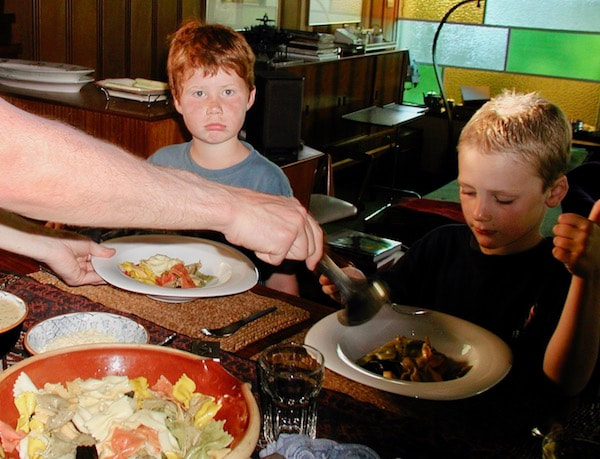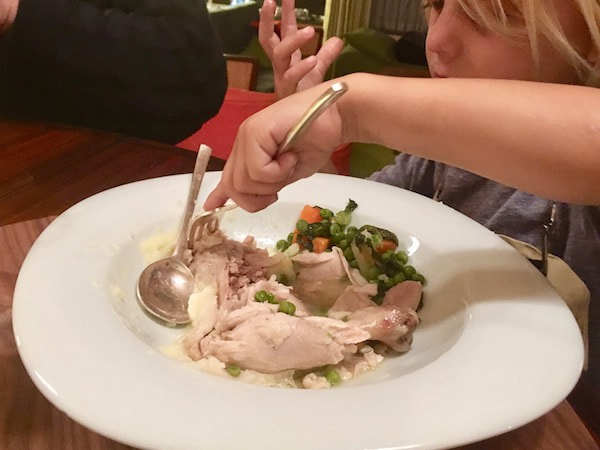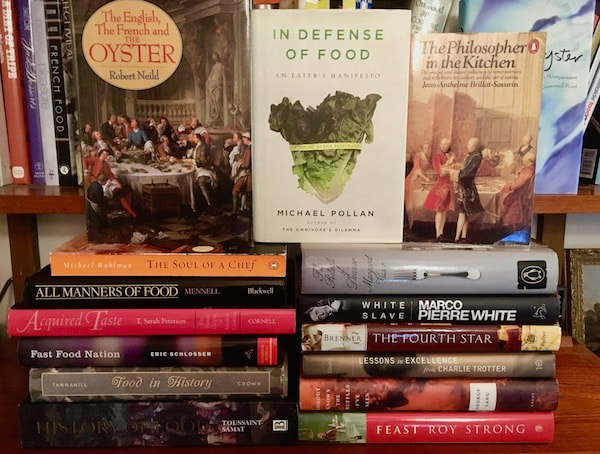|
I was at the market recently, standing in line behind a family - mum and three children. She asked them what they wanted for dinner that evening. One wanted pizza, one wanted pasta, one wanted sausages. It was clear that four different meals were going to be prepared. Why, oh why, was the question ever asked? This is just so not what I'm used to. If we had asked my mother what we were having that night, she might have replied "liver with onions & parsley, mashed potatoes (pommes purées) and carrots" and we would have shouted "Yummy!" Perhaps we were lucky that both our parents made our food sound marvellous - and it was. Sitting together was not just normal; it was a very agreeable moment in the day. We were expected to have a story and more importantly perhaps, to listen to my father's stories! (My anglo-saxon friends were amazed that we were allowed to talk during meals!) We were not asked what we wanted. We were told what we were having (like being at a simple country hotel). So how do you make a gourmet? Perhaps you might ask first why you would want to make a gourmet. Gourmets are easy-going, happy kids. They don’t make a fuss. They’re easy to look after, they’re enthusiastic, you can take them anywhere, they’ll smile at a bowl of lovely chips as easily as at a truffled guinea fowl with duck-fat-fried potatoes. They’re cheap, they’re accommodating. Needless to say, you will be aware of any harmful allergies – peanuts might be fatal, chocolate could bring on unbearable eczema, prawns could inhibit normal respiration. So, to make a gourmet, this is our method. It works. Firstly, you must accept that everyone in the family eats the same thing and all sit together at a table for most main meals. No more one meal for Johnny, another meal for Annabel, another for Hepzibah, another for the adults. Serve the meal and don’t make a fuss. Allow your child to choose not to eat certain vegetables but put them out, nonetheless, day after day, day after day. Someone may not like carrots. Just keep putting them out. This normalises the meal and your choices. Your child will not starve. This might be hard but it will work in the end. Get everyone involved. Children can lay the table, they can peel carrots, they can wash lettuce. Food can be parcelled out individually but a platter brought to the table will illicit a "Wow". And start them early on eating from a plate and with (yes) cutlery. Never too early to learn where to place that important little forefinger on the fork.
If we don’t encourage children to eat everything and develop a broad palate, where are the gourmets and polite eaters of tomorrow? Never make a fuss, never penalise, never bribe, never complain, never explain. Just keep serving them. One day those discarded black olives will be tried and accepted, that grilled red capsicum will be eaten along with the rest. It’s a little bit of tough love. You are the tour operator around the world of good, real food. You are the adult. Comment or like below👇
10 Comments
I recently mentioned having enjoyed Bee Wilson's book "The Way We Eat Now". She touches on, among other things, the loss of the lunch hour, unhealthy "health foods", and our busy, busy lives.
I've also just finished two books by Michael Booth – "Sushi and Beyond: What the Japanese Know About Cooking" and "The Meaning of Rice: and Other Tales from the Belly of Japan." I admire his honesty in admitting that as a self-avowed Japanophile, he nonetheless finds the level of pedantry involved in the Japanese tea ceremony to be mind-numbingly boring. “I can’t quite see how watching a pedantic elderly woman take two hours to make a cup of matcha (tea) will enhance my life.” Both books are riveting and got me into a week of ramen, okonomiake, chawan mushi and mochi. I miss not being able to talk with friends about what I read. Friends? I have friends. Some belong to book clubs - crime, romance, dystopia, historical fiction, WWII but what I really want is to be free to discuss my gastronomic readings without anyone rolling their eyes. So it's occurred to me. How about a book club! I guess we'd meet once a month. Someone would make a suggestion for the next gathering. How many readers? I guess 8 to 10 at the absolute most. Would we have tea and madeleines or wine and anchovies on horseback? So much to work out but the reading possibilities are endless. There's history, health, sociology, philosophy, biography, science...
The world doesn't need another cook book or another recipe. They're already out there, somewhere in the cloud, in the ether or on a bookcase near you. But it would be lovely to gather with consenting adults in private and talk gastronomy. What do you think? There could be chapters all over the country, all over the world. Let's get up a group. Add your comment below and sign up for the future! See small print - 👇 Home from a week in Hobart, I was greeted by this magnificent display. The Cattleya (bought last year at the Royal Adelaide Show) had opened with 4 enormous blooms. Cattleyas are no longer fashionable but I adore their vulgarity and they're my orchid of choice. The popular phalaenopsis (the white, flat-leaved, S.E. Asian "moth" orchid) is a long lasting, good little trooper, pretty, but... These were the orchids used (circa 1950s) for a corsage offered to a dance date, worn high on the shoulder or even on the wrist. In the film of Proust's Remembrance of Things Past, Swann "flirts" with a Cattleya thrust in the bodice of Odette, his pulchritudinous mistress. Hobart is very accessible, with great art, great produce, great seafood, great markets and therefore good restaurants. The highlight for me (and possibly one of my best experiences ever) was meeting Ainstie Wagner, the lively, energetic, knowledgeable, executive chef of Tasmanian Government House who showed me around her domain. (Allowed into the vault to see the silver, the teapots, the salt cellars, asparagus servers, the salvers, the marrow spoons - not often called for - I was rendered speechless.) Then followed a walk around her ordered and immaculate kitchen, her store-room of preserves, the produce garden with its chickens, its soft fruit canes, its nut and fruit trees, its rows of rhubarb, spinach, carrots. She is also working on adding to their two crocus plants for their own saffron! A tale of two flowers. The Cattleya originated in Brazil where it grew wild in trees. (It's epiphytic i.e. it attaches itself but thrives independently.) It was brought to England in the early 1800s. British botanist explorers in fact found many flowers in South America to add to the English garden. The vanilla orchid (Vanilla Planifolia) has a similar shape, but very much smaller, about 12cm long, pale green and cream and grows as a vine. While the Cattleya flower will last sometimes six weeks, the vanilla orchid fades in a day, after which the vanilla bean, its fruit, develops. The vines must be checked daily. From Mexico, the explorer Cortez introduced vanilla to Europe in the early 1500s where is was an instant success. More and more plantings were gradually set up in Madagascar, Indonesia and Tahiti. Pollination by bees is erratic and hand pollination was developed in 1840 by a 12 year old slave, Edmond Albius, in Madagascar. So what with one thing and another, vanilla is time consuming to grow, very much in demand and therefore very expensive. It's a ubiquitous flavouring - think vanilla ice-cream. When my Cattleya flowers fade, I will carefully watch the development of the bean. It will not be a vanilla bean of course, but I will feel a connection. And so to the saffron crocus. This little crocus (Crocus Sativus) is just like the bulb you might plant at home, along with the daffs, hyacinths and snowdrops. It grows in clusters, has a lovely mauve flower, but stands out with its three (yes, three only) red stamens - the saffron. While you're unlikely to pick up a vanilla orchid at a nursery near you, it would be possible to find a supplier of saffron crocus bulbs. Harvesting however may deter your enthusiasm. (There are nonetheless some small Tasmanian growers.)
The saffron crocus spread across Europe from the middle east. It's grown extensively now in Iran, Spain and Portugal. The flowers are harvested then the stamens are collected, three at a time! Saffron is time consuming to grow, very much in demand and therefore very expensive. With saffron I am incredibly fortunate. I am suppled by my rug dealer (I said rug, not drug dealer) Javad Alikorki and by the artist Hossein Vallamanesh when either returns from a trip home to Iran. My advice for using vanilla or saffron? Choose your dish well and don't skimp. The Spaniards might throw saffron around with gay abandon in their paella but we might be more circumspect. But using not quite enough because you're "saving" it, is a total waste. "Saving" vanilla beans is also a waste. They might dry out. I have precious vanilla beans stored in castor sugar and the flavour permeates the container and will keep on doing so over a year. This way, the flavour can grace most sweet things. It's very effective. (And you may like to know that artificial "vanillin" is a flavour compound from the petrochemical industry - the devil's work!) P.S. The saffron-coloured robes worn by monks are not dyed with saffron (and never have been). Imagine the kilos required! When do you use vanilla? When do you use saffron? Comment or like - see the fine print below.👇 |
Categories
All
|










 RSS Feed
RSS Feed
